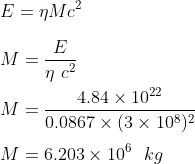In 2019, the U.S. consumed about 1.483x1019) of energy. Assume that, in some future year, the U.S. will consume 4.84x1022J of energy. Also, suppose a process is developed to convert matter into energy that is 8.67% efficient. Using this process, find M, the amount of mass in kilograms that must be converted to energy to meet U.S. energy needs in this future year.
In 2019, the U.S. consumed about 1.483x1019) of energy. Assume that, in some future year, the U.S. will consume 4.84x1022J of energy. Also, suppose a process is developed to convert matter into energy that is 8.67% efficient. Using this process, find M, the amount of mass in kilograms that must be converted to energy to meet U.S. energy needs in this future year.
Related questions
Question
Question in the Attachments

Transcribed Image Text:In 2019, the U.S. consumed about 1.483x1019j of energy.
Assume that, in some future year, the U.S. will consume 4.84x1022j of energy. Also, suppose a process is developed to convert matter into energy that is 8.67%
efficient. Using this process, find M, the amount of mass in kilograms that must be converted to energy to meet U.S. energy needs in this future year.
Expert Solution
Concept
The mass-energy equivalence relation is given by

Where E = Energy produced,  = Efficiency of matter to energy conversion, M = amount of mass,
= Efficiency of matter to energy conversion, M = amount of mass,
c = Speed of light in vacuum = 3 × 108 m/s
Answer
In the future year, the energy consumed by U.S. is E = 4.84 × 1022 J
The efficiency of matter to energy conversion  = 8.67 % = 0.0867
= 8.67 % = 0.0867
c = Speed of light in vacuum= 3 × 108 m/s
Let M = amount of mass
The mass-energy equivalence relation is given by

Step by step
Solved in 3 steps with 4 images
